I'll make sure each section is between 100-120 words and includes descriptive headings that incorporate "Japandi bathroom" to maintain keyword relevance. I'll also ensure variety in the opening sentences as specified in the instructions.Transform your bathroom into a serene sanctuary that harmoniously blends Japanese minimalism with Scandinavian functionality. Japandi bathroom design represents the perfect fusion of East-meets-West aesthetics, creating spaces that prioritize tranquility, natural beauty, and mindful living. This design philosophy emphasizes clean lines, neutral color palettes, natural materials, and clutter-free environments that promote relaxation and well-being. Whether you're planning a complete renovation or simple updates, these carefully curated ideas will help you achieve an authentic Japandi bathroom that serves as a peaceful retreat from daily stress.
1. Japandi Bathroom Natural Wood Vanity Design
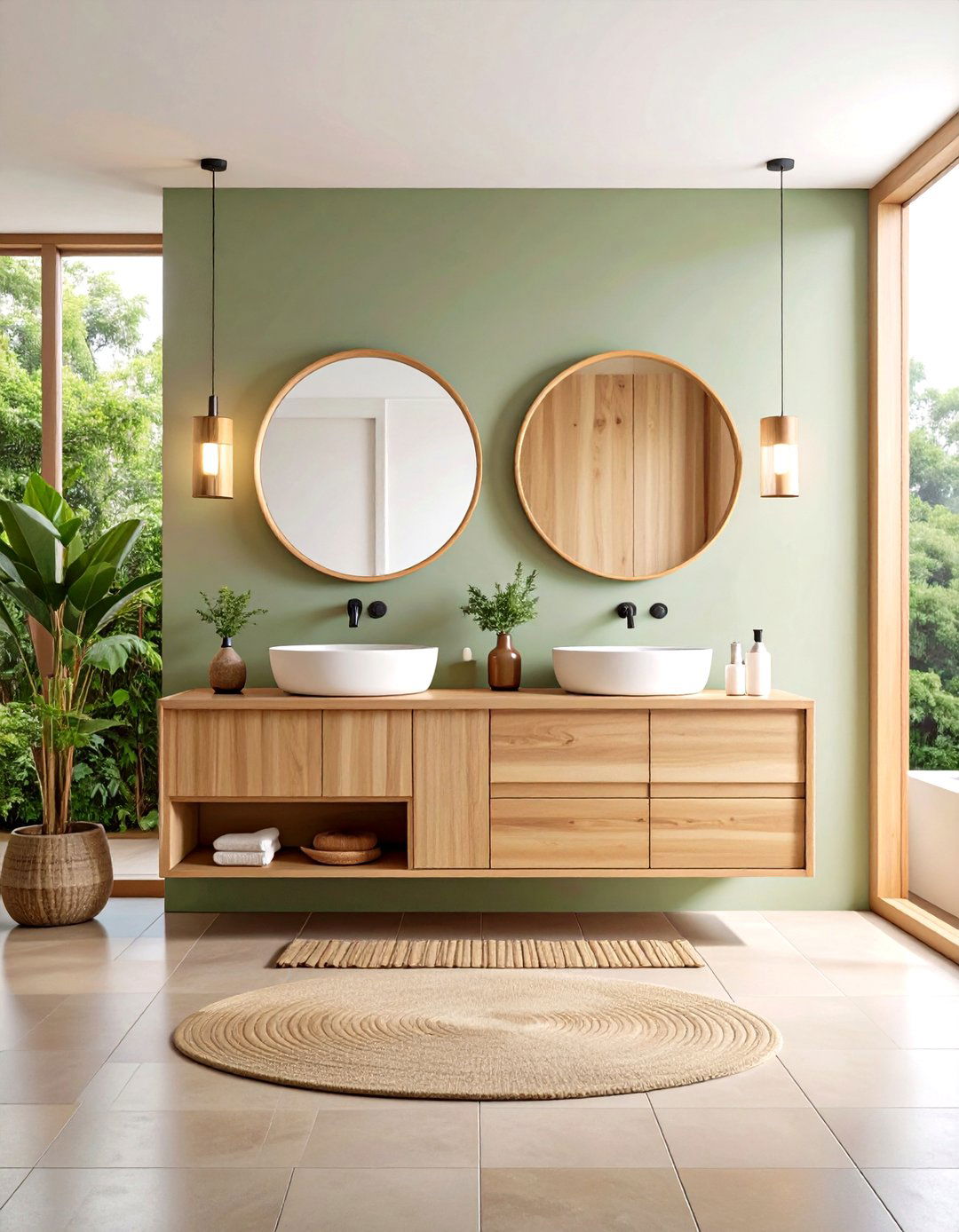
Wooden vanities form the heart of authentic Japandi bathroom design, bringing warmth and organic texture to your space. Choose light woods like oak, maple, or birch for a Scandinavian influence, or opt for darker cedar and walnut to embrace Japanese traditions. The vanity should feature clean, simple lines with minimal hardware to maintain the minimalist aesthetic. Consider floating designs that create visual spaciousness while incorporating hidden storage to keep surfaces clutter-free. Natural wood grain patterns add visual interest without overwhelming the serene atmosphere. Pair your wooden vanity with complementary stone countertops or integrated sinks for a harmonious blend of natural materials that exemplifies the Japandi philosophy of celebrating nature's inherent beauty.
2. Japandi Bathroom Stone Vessel Sink Elements
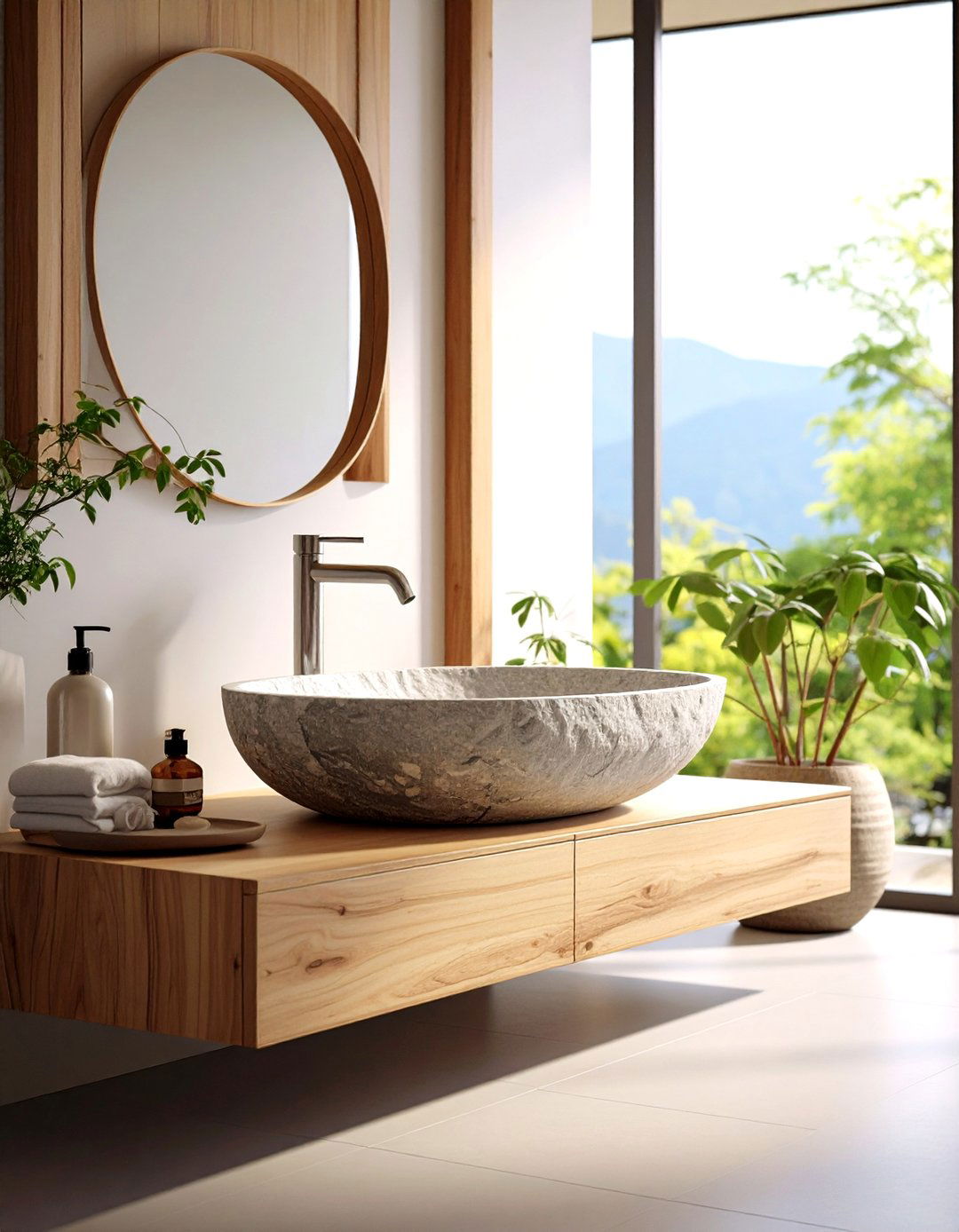
Stone vessel sinks epitomize the Japandi bathroom's connection to natural elements, creating stunning focal points that celebrate imperfection and authenticity. Consider materials like granite, marble, basalt, or river stone that showcase unique patterns and textures inherent to natural stone formation. These sinks embody the Japanese wabi-sabi philosophy by embracing irregular shapes and natural variations that make each piece distinctive. Position the vessel sink atop wooden vanities or natural stone countertops to create beautiful material contrasts. The organic forms soften the overall bathroom design while maintaining functionality. Choose rounded or oval shapes that complement the minimalist aesthetic, and pair with simple, streamlined faucets in matte black or brushed finishes. This combination creates a spa-like atmosphere that promotes mindfulness and relaxation.
3. Japandi Bathroom Freestanding Soaking Tub Centerpiece
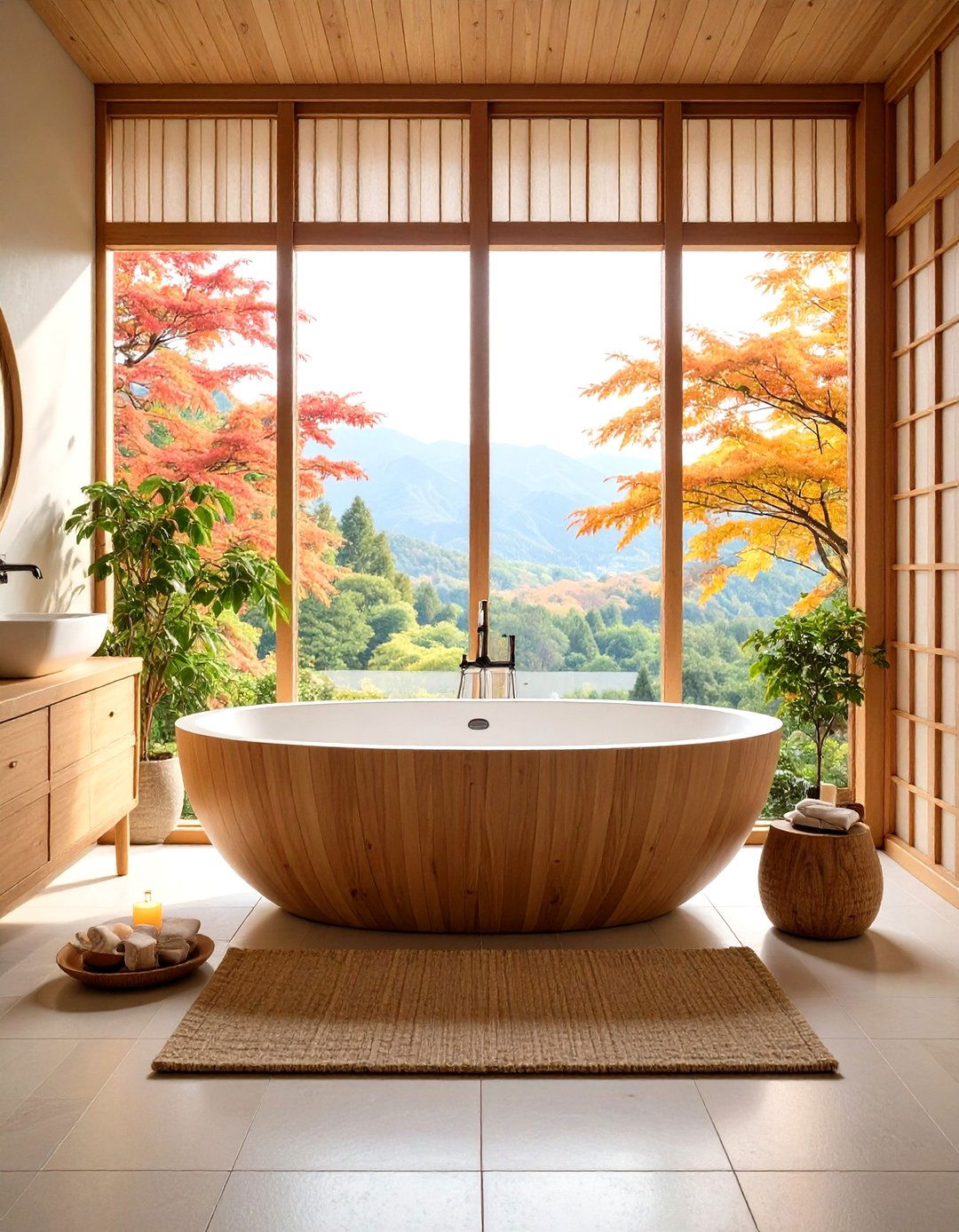
A freestanding soaking tub serves as the ultimate centerpiece in Japandi bathroom design, embodying the Japanese tradition of therapeutic bathing for both physical and spiritual cleansing. Choose deep, oval designs with clean lines that mimic traditional Japanese ofuro tubs, prioritizing comfort and contemplation over elaborate styling. Position the tub strategically near windows to maximize natural light during relaxation, or create an intimate nook with soft ambient lighting and carefully placed plants. The bathtub should appear to float within the space, creating visual breathing room that enhances the minimalist aesthetic. Consider adding a wooden bath caddy or stone platform nearby for practical storage of bath essentials. This arrangement transforms bathing from a routine activity into a mindful ritual that promotes stress relief and rejuvenation.
4. Japandi Bathroom Neutral Color Palette Harmony
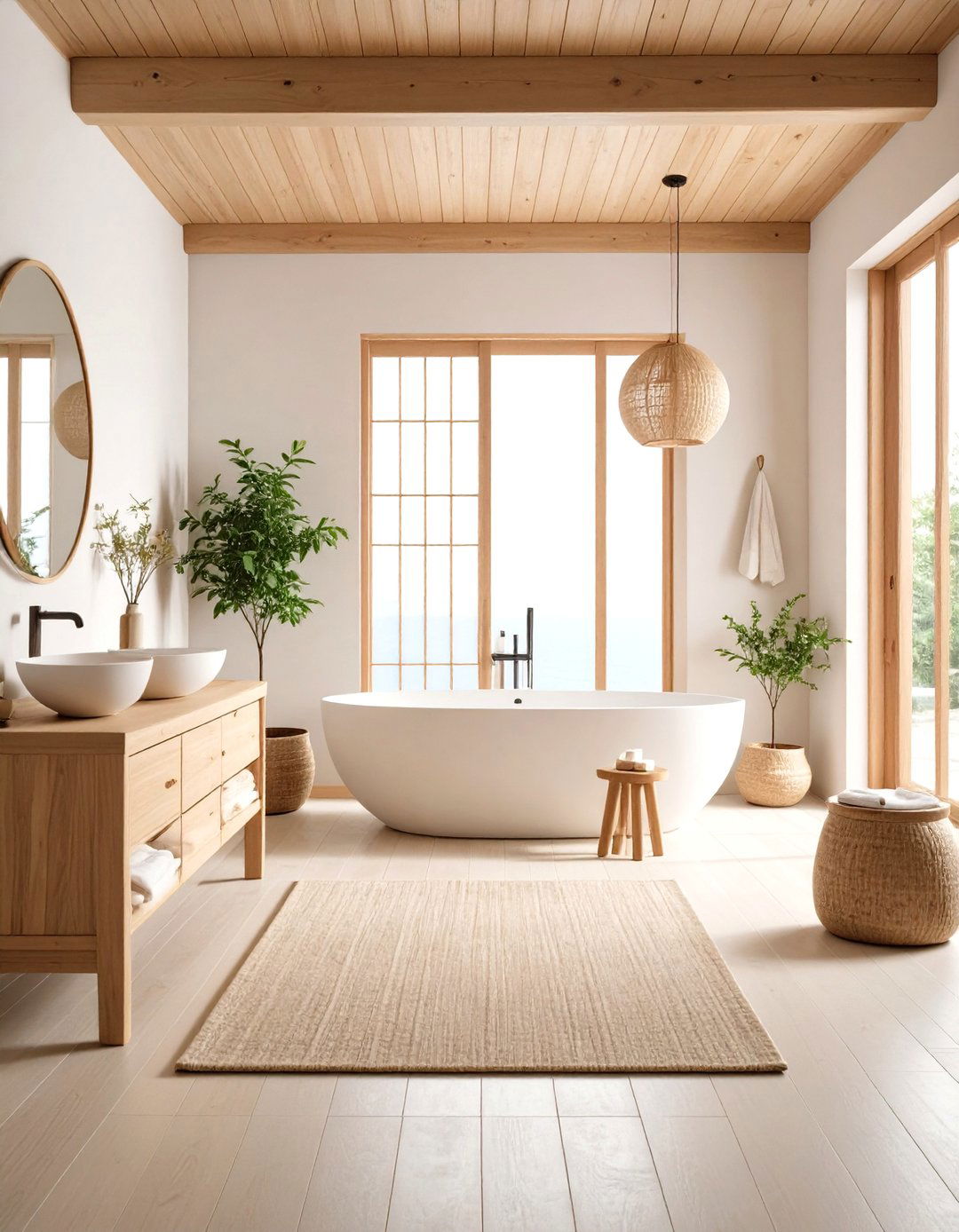
The foundation of successful Japandi bathroom design lies in carefully curated neutral color schemes that promote tranquility and balance. Embrace muted tones including warm whites, soft beiges, gentle grays, and pale wood tones that create calming backdrops. These colors work together to establish serenity while providing flexibility for natural material integration. Consider layering different neutral shades to add depth and visual interest without overwhelming the space. Soft greens and blues can serve as subtle accent colors, drawing inspiration from nature while maintaining the overall peaceful atmosphere. The key principle involves choosing colors that complement rather than compete with natural materials like wood and stone. This thoughtful approach ensures your bathroom feels cohesive and restful, supporting the Japandi goal of creating spaces that nurture both body and mind.
5. Japandi Bathroom Minimalist Storage Solutions
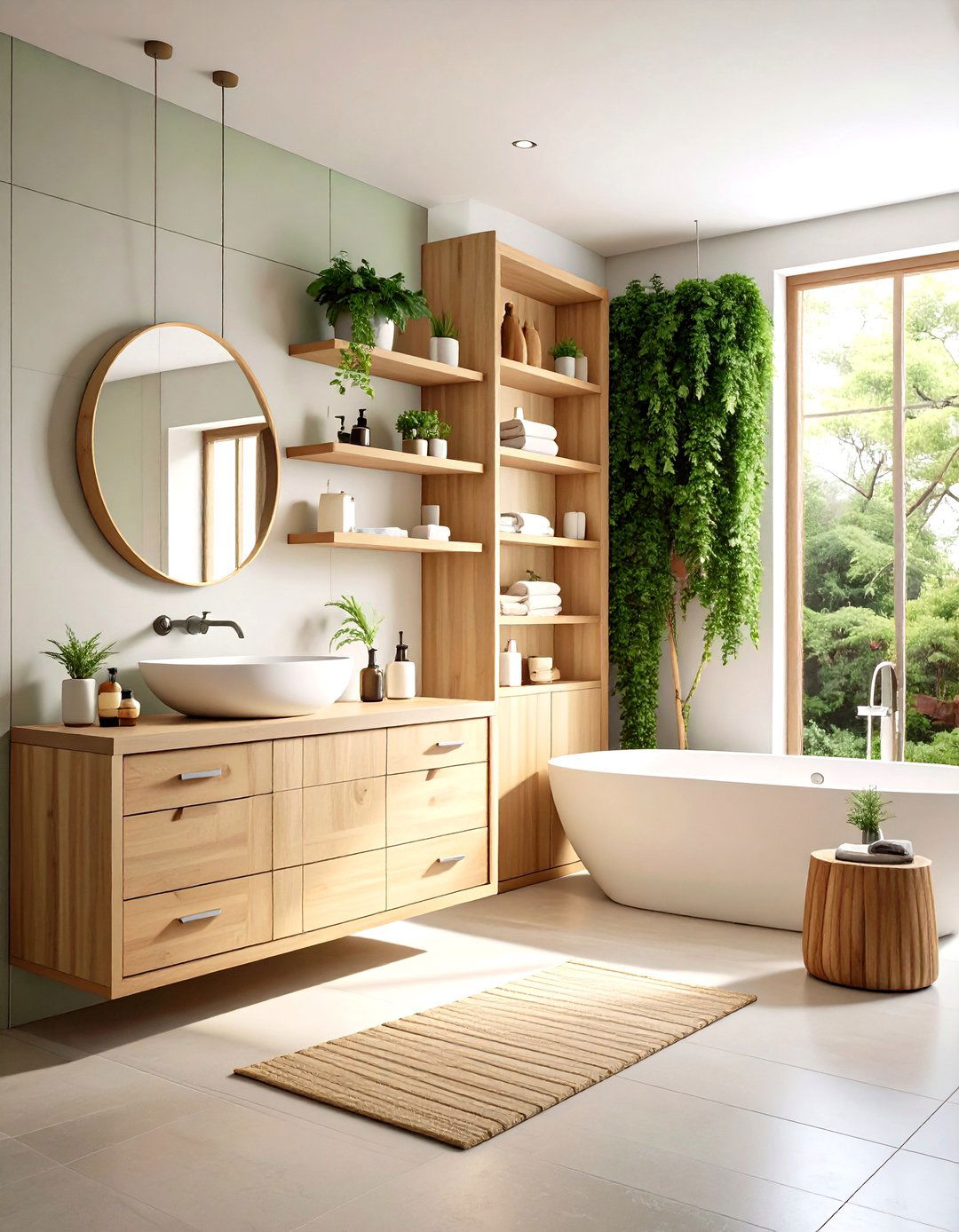
Effective storage solutions in Japandi bathroom design prioritize functionality while maintaining the essential clutter-free aesthetic that defines this style. Built-in wall niches, floating shelves, and concealed cabinets ensure everyday necessities remain accessible yet invisible when not in use. Choose storage pieces in natural materials like bamboo, wood, or woven rattan that complement the overall design language. Wall-mounted vanities with hidden compartments maximize floor space while providing ample storage for toiletries and personal items. Consider installing recessed medicine cabinets behind mirrors to eliminate visual clutter on countertops. The Scandinavian influence emphasizes smart storage solutions that combine beauty with practicality, ensuring every item has a designated place. This organizational approach supports the Japanese principle of mindful living by creating spaces free from distractions and unnecessary possessions.
6. Japandi Bathroom Bamboo Accessories Integration
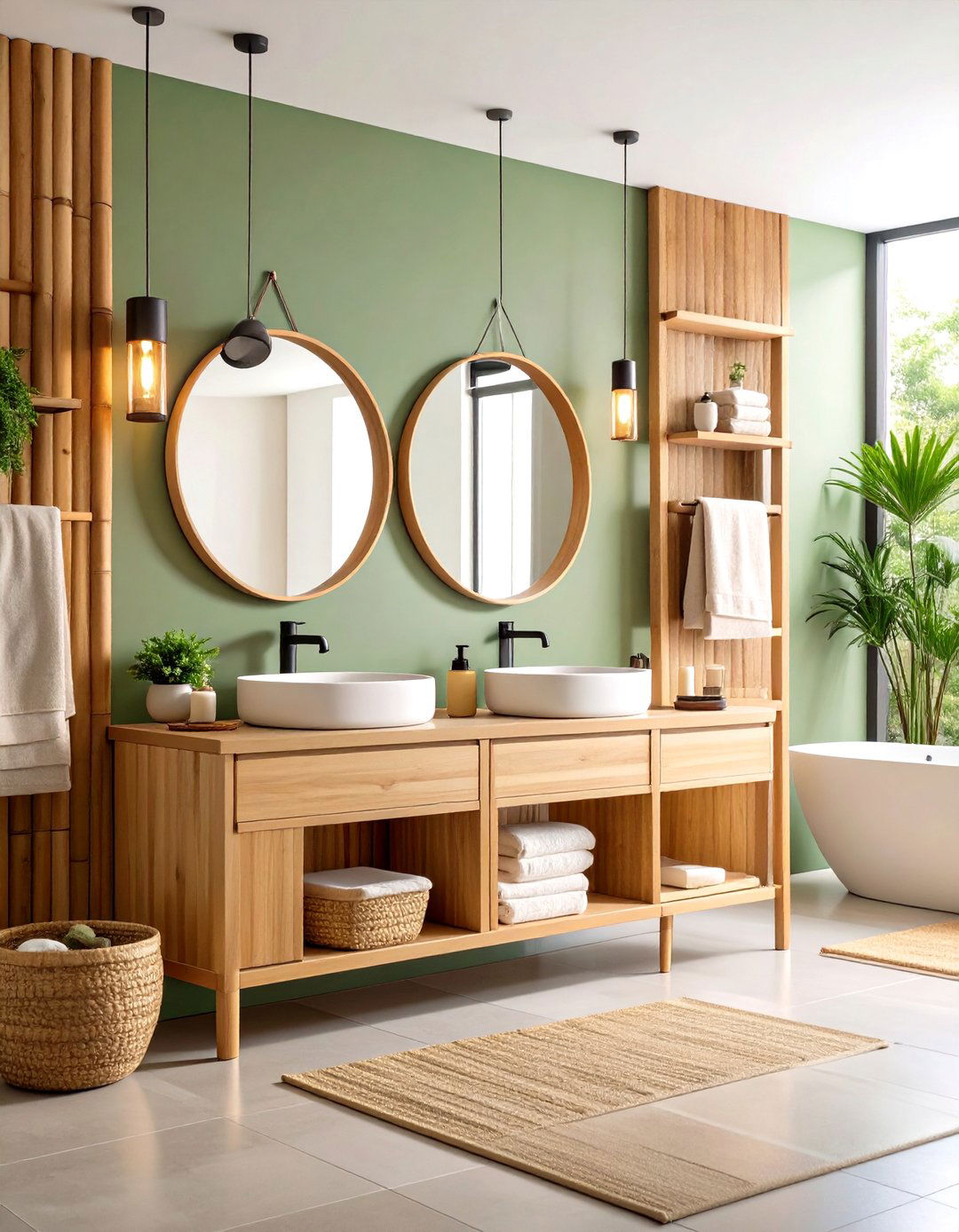
Bamboo accessories bring sustainable elegance to Japandi bathroom design while honoring both Japanese and Scandinavian commitments to environmental consciousness. Incorporate bamboo through towel racks, soap dispensers, toothbrush holders, and storage containers that add natural texture without overwhelming the space. These accessories provide subtle contrast against stone and wood elements while maintaining the organic aesthetic central to Japandi philosophy. Choose pieces with simple, geometric forms that emphasize the material's natural beauty rather than elaborate decorative details. Bamboo's lightweight yet durable qualities make it perfect for humid bathroom environments while supporting eco-friendly design principles. Consider larger bamboo elements like bath mats or storage baskets that can serve as functional focal points. The material's rapid growth and renewability align perfectly with the Japandi emphasis on sustainability and mindful consumption.
7. Japandi Bathroom Soft Ambient Lighting Design
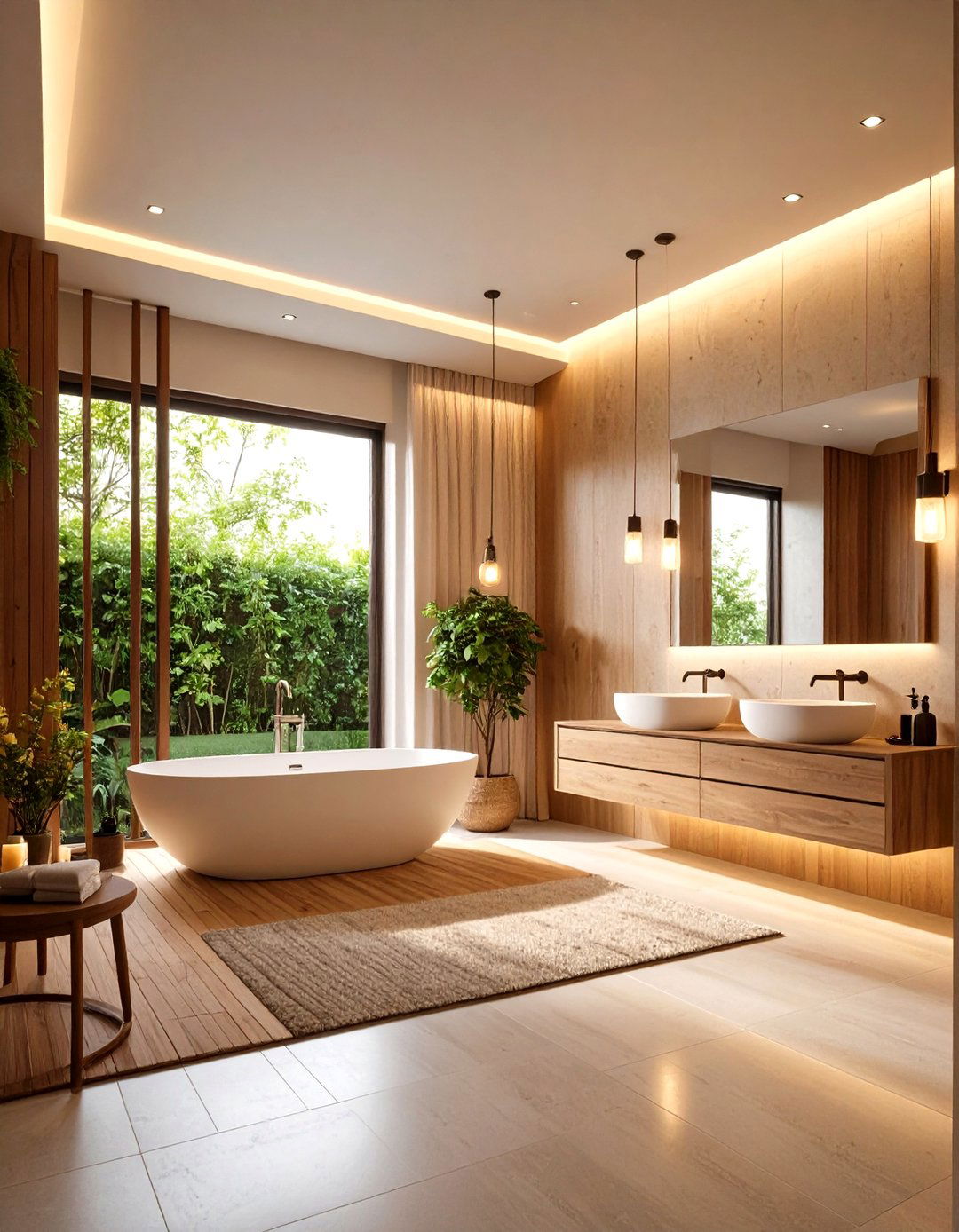
Lighting design in Japandi bathrooms requires careful balance between functionality and atmosphere, creating spaces that support both daily routines and relaxation rituals. Maximize natural light through large windows or skylights whenever possible, using sheer curtains or frosted glass for privacy without blocking illumination. For artificial lighting, choose warm LED bulbs between 1800-2700 Kelvin that create soft, golden glows reminiscent of candlelight. Layer different lighting sources including wall sconces, pendant lights, and mirror lighting to provide flexibility for various activities. Consider Japanese-inspired paper lanterns or wooden fixtures that diffuse light gently throughout the space. Avoid harsh overhead lighting that can disrupt the serene atmosphere essential to Japandi design. The goal involves creating lighting environments that feel natural and calming, supporting the bathroom's role as a personal sanctuary for renewal and reflection.
8. Japandi Bathroom Natural Textile Integration
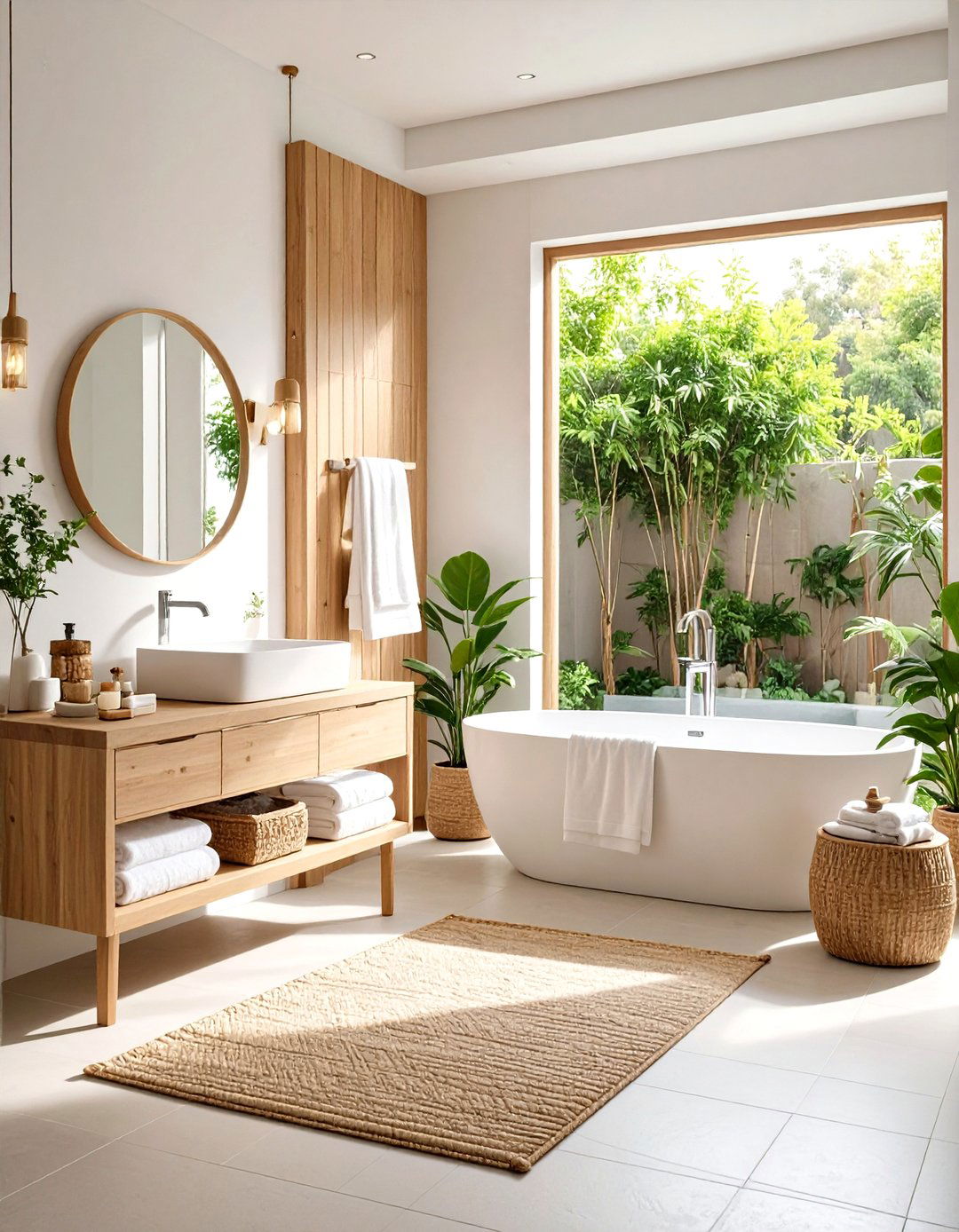
Incorporating natural textiles adds essential warmth and comfort to Japandi bathroom design while maintaining the minimalist aesthetic central to this style. Choose high-quality towels, bath mats, and window treatments in organic materials like cotton, linen, or bamboo fiber that feel luxurious against the skin. Colors should remain neutral – whites, creams, soft grays, and natural beiges that complement the overall palette. The texture becomes the primary source of visual interest, with woven patterns, subtle ridges, and natural fiber variations adding depth to the design. Consider oversized bath towels and plush bathrobes that enhance the spa-like experience. Limit textile choices to a few carefully selected pieces to avoid visual clutter while ensuring maximum comfort. These soft elements balance the harder surfaces of stone and wood, creating spaces that feel both sophisticated and inviting.
9. Japandi Bathroom Indoor Plant Zen Atmosphere
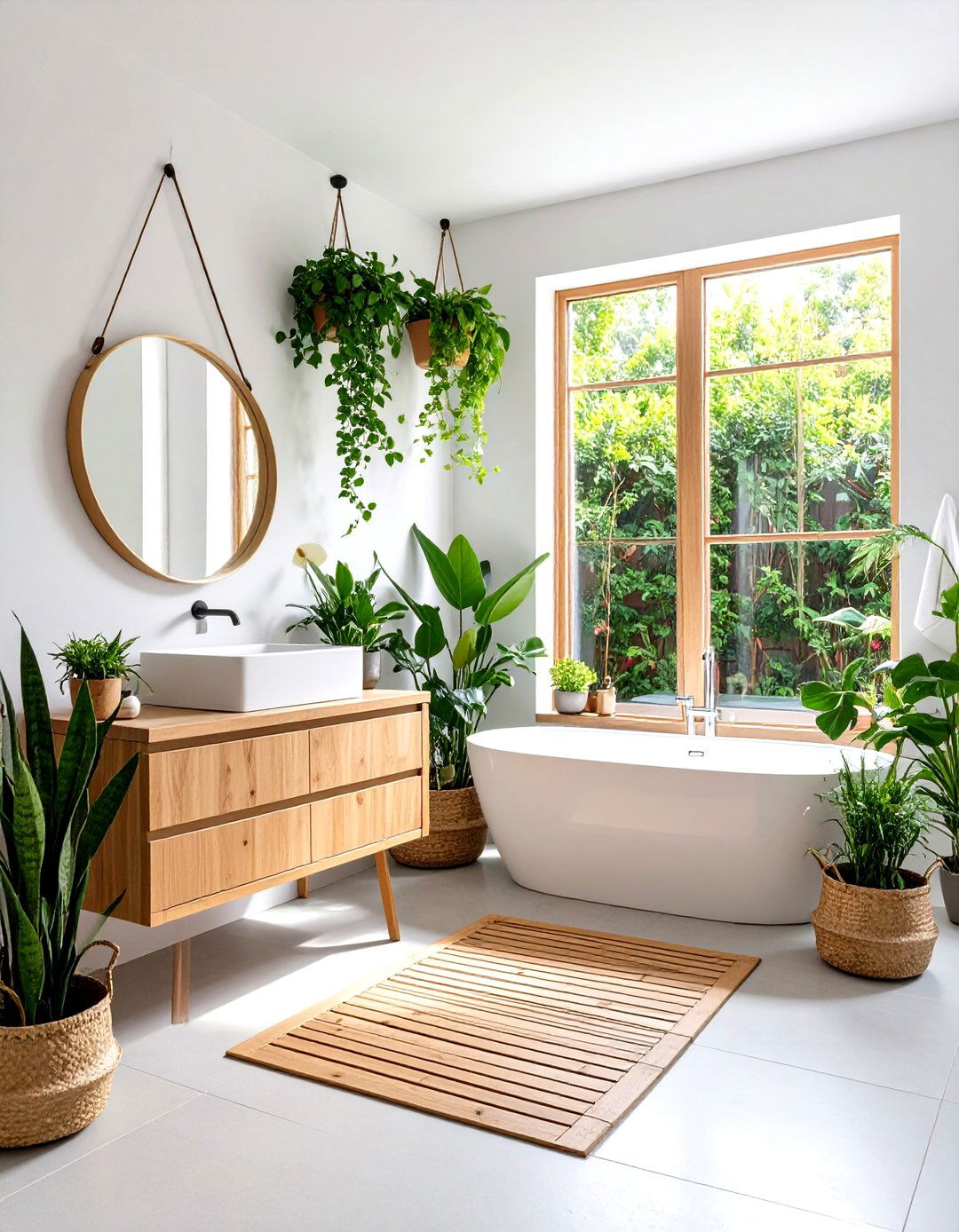
Strategic plant placement transforms Japandi bathrooms into living spaces that celebrate the profound connection between humans and nature. Choose low-maintenance varieties like snake plants, peace lilies, bamboo, or ferns that thrive in humid bathroom environments while requiring minimal care. Position larger plants in simple, minimalist planters made from natural materials like ceramic, wood, or woven baskets that complement the overall design aesthetic. The Japanese principle of bringing nature indoors enhances air quality while creating visual focal points that promote calm and mindfulness. Consider single statement plants rather than multiple small specimens to maintain the clean, uncluttered look essential to Japandi design. Plants should appear naturally integrated into the space rather than decorative afterthoughts, supporting the philosophy that every element serves both functional and spiritual purposes in creating harmonious living environments.
10. Japandi Bathroom Matte Black Fixture Accents
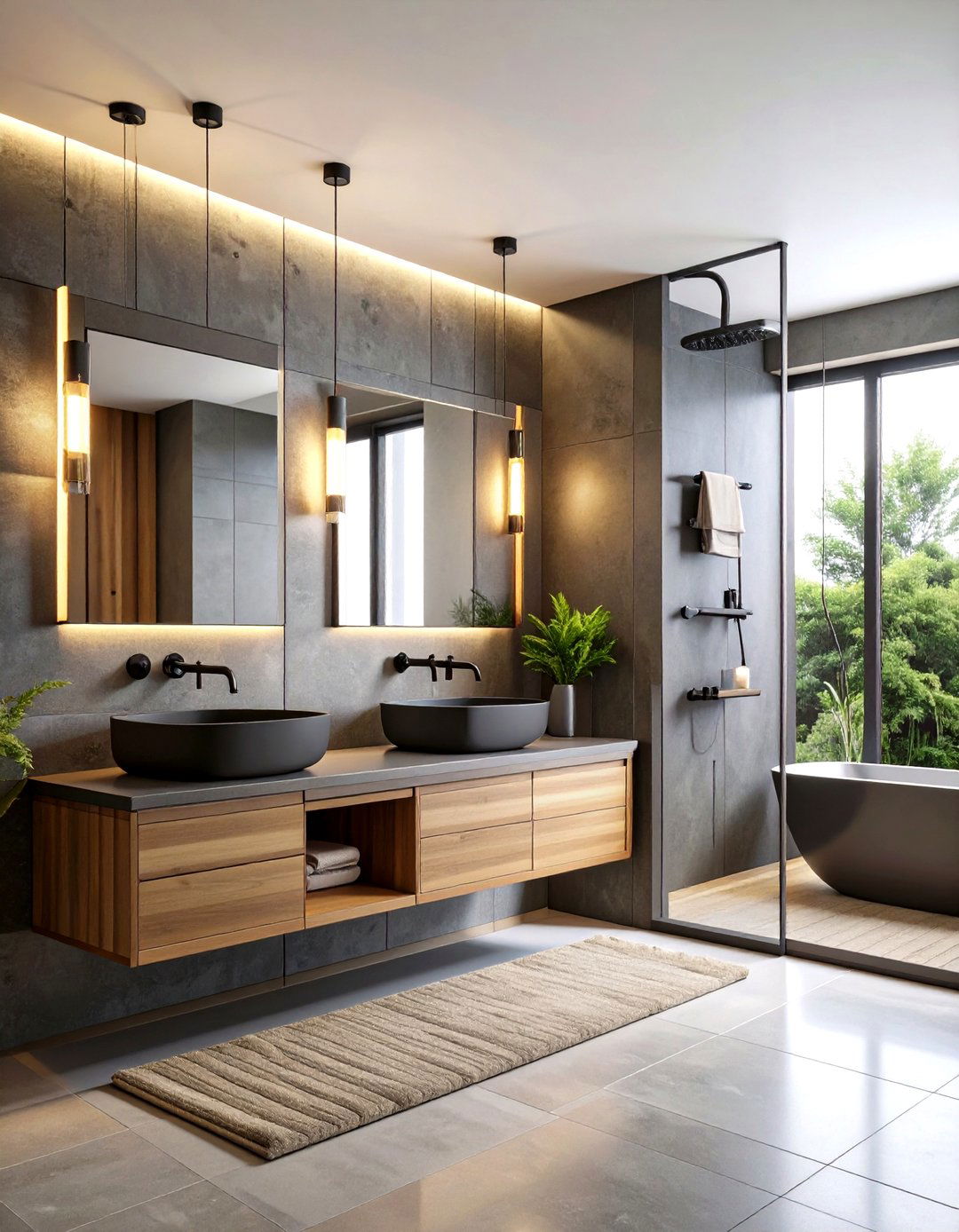
Matte black fixtures provide striking contrast in Japandi bathroom design while honoring Japanese aesthetic principles that embrace bold simplicity. Choose faucets, showerheads, towel bars, and cabinet hardware in matte black finishes that create visual anchor points against neutral backgrounds. These dark accents prevent the space from appearing washed out while adding sophistication and depth to the overall design. The key involves using black elements sparingly and strategically rather than overwhelming the serene atmosphere with too much contrast. Consider how these fixtures interact with natural materials like wood and stone, creating balanced compositions that feel intentional rather than accidental. Matte finishes hide water spots and fingerprints better than polished alternatives, supporting the low-maintenance lifestyle central to Japandi philosophy. This approach demonstrates how thoughtful contrast can enhance rather than compete with the peaceful, harmonious atmosphere essential to successful bathroom design.
11. Japandi Bathroom Natural Stone Flooring
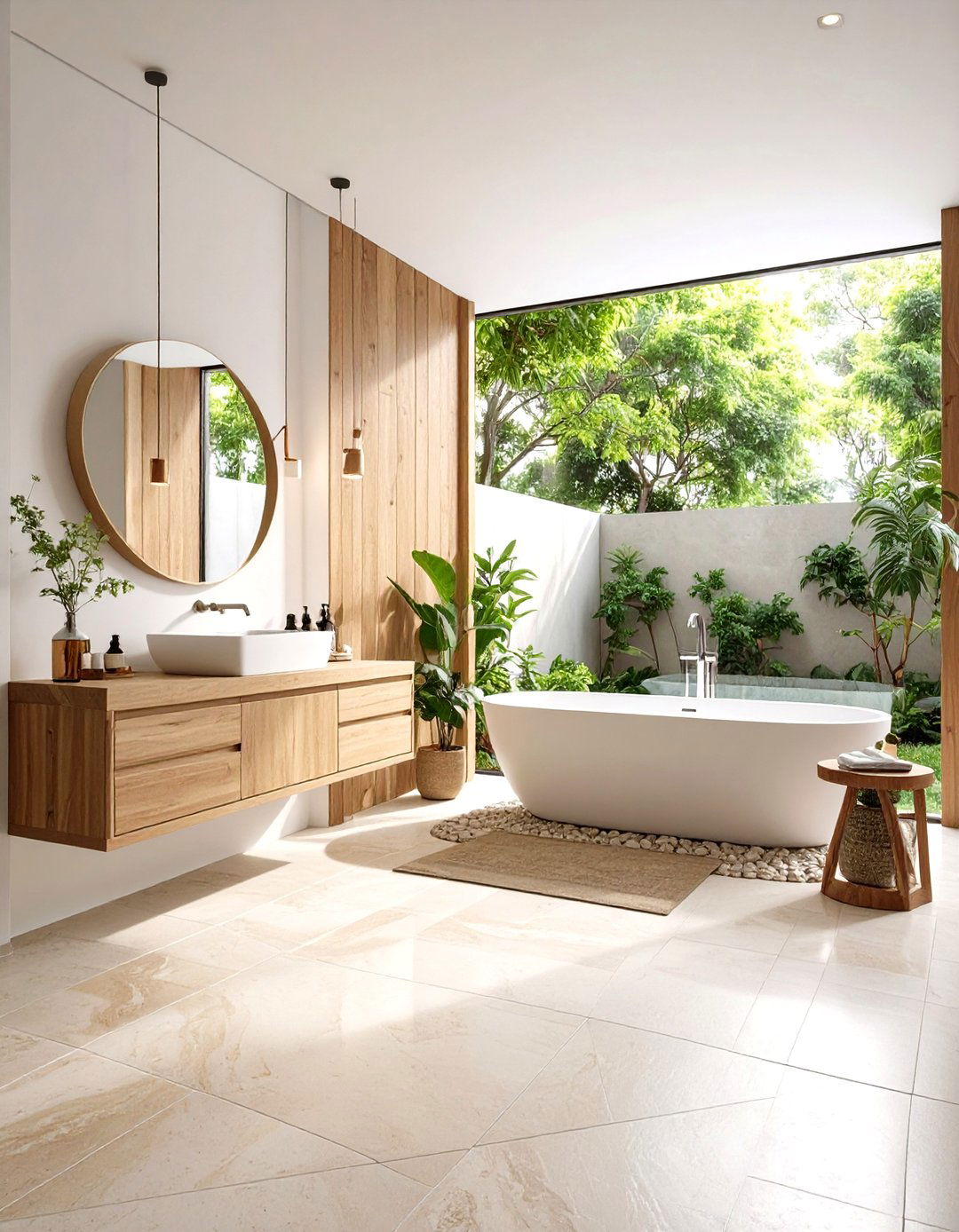
Natural stone flooring establishes the foundational element in Japandi bathroom design, providing durability, beauty, and connection to earth's inherent patterns. Consider materials like travertine, limestone, slate, or river rock that showcase natural variations and imperfections celebrated in Japanese wabi-sabi philosophy. Large-format tiles minimize grout lines for cleaner appearances while highlighting the stone's natural beauty. The Scandinavian influence emphasizes functionality, making stone an ideal choice for bathroom environments requiring water resistance and easy maintenance. Choose neutral tones that complement wooden vanities and other natural materials without competing for visual attention. Stone's thermal mass helps regulate temperature while its texture adds subtle interest underfoot. Consider radiant heating systems beneath stone floors for enhanced comfort during colder months. This foundation creates timeless elegance that supports the Japandi goal of designing spaces that feel both luxurious and grounded in natural simplicity.
12. Japandi Bathroom Organic-Shaped Mirror Elements

Organic-shaped mirrors soften the geometric lines common in Japandi bathroom design while adding visual interest through curved, natural forms. Choose round, oval, or irregularly shaped mirrors that mimic stones, leaves, or other natural elements rather than traditional rectangular designs. These softer shapes create balance against angular fixtures and straight lines while maintaining the minimalist aesthetic essential to the style. Consider frameless designs or simple wooden frames that don't compete with the mirror's organic shape. Position mirrors strategically to reflect natural light and create the illusion of larger space while serving practical grooming needs. The curved forms introduce a sense of movement and flow that enhances the peaceful atmosphere central to Japandi philosophy. Multiple smaller mirrors can create interesting compositions while maintaining functionality, or single large organic mirrors can serve as statement pieces that anchor entire vanity areas.
13. Japandi Bathroom Japanese-Inspired Sliding Door Privacy
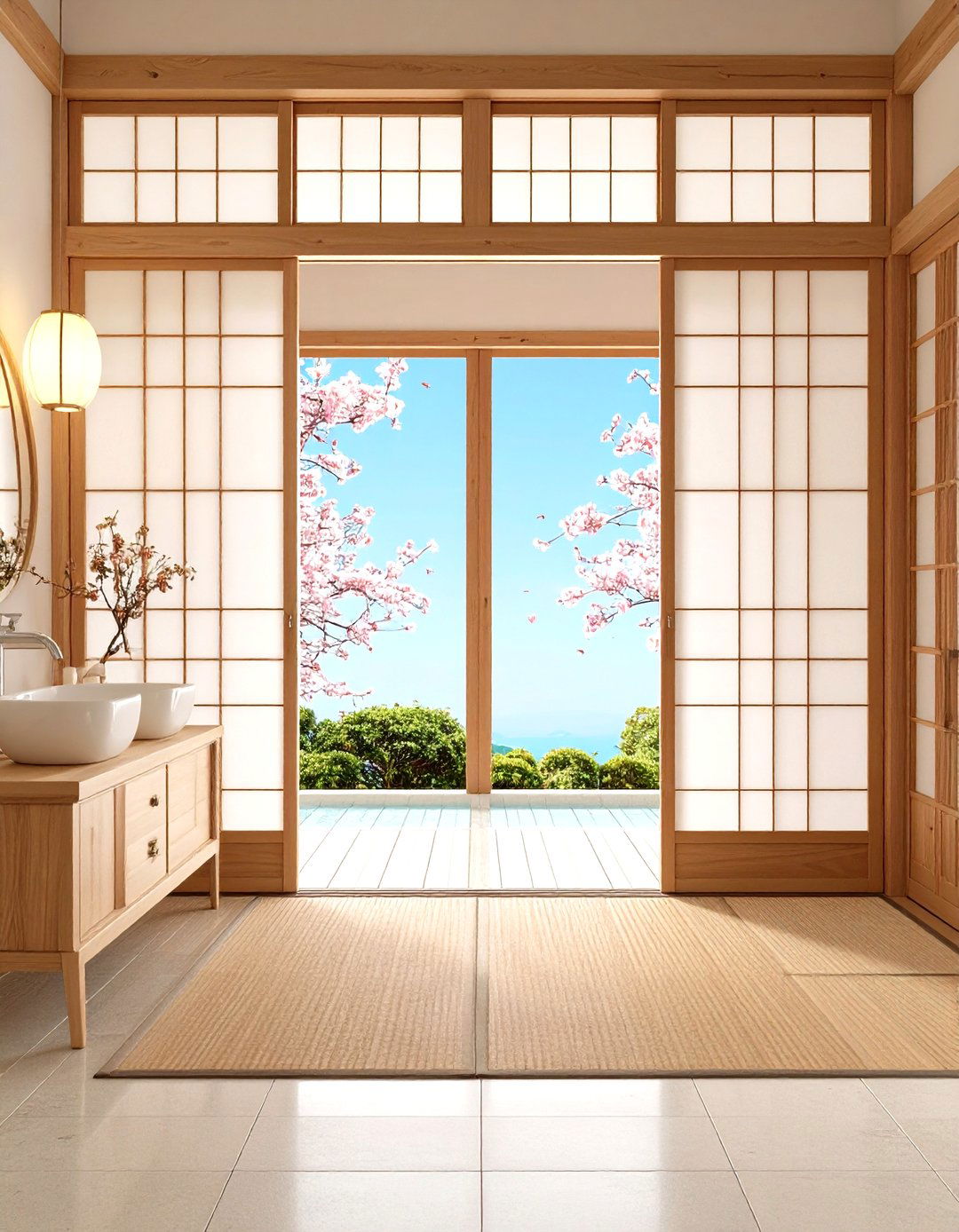
Sliding doors inspired by traditional Japanese shoji screens bring authentic cultural elements to Japandi bathroom design while maximizing space efficiency. These panels can separate toilet areas, create private dressing zones, or serve as unique shower enclosures that maintain visual flow throughout the space. Choose designs with simple wooden frames and translucent materials like frosted glass or natural paper that allow light transmission while providing privacy. The sliding mechanism saves valuable floor space compared to traditional hinged doors, making them ideal for smaller bathrooms seeking to maximize functionality. Consider custom designs that complement existing architectural elements while honoring Japanese craftsmanship traditions. These doors can be positioned to create flexible spaces that adapt to different usage needs throughout the day. The clean lines and natural materials align perfectly with Japandi principles while adding authentic cultural depth to contemporary bathroom design.
14. Japandi Bathroom Built-In Wall Niche Storage
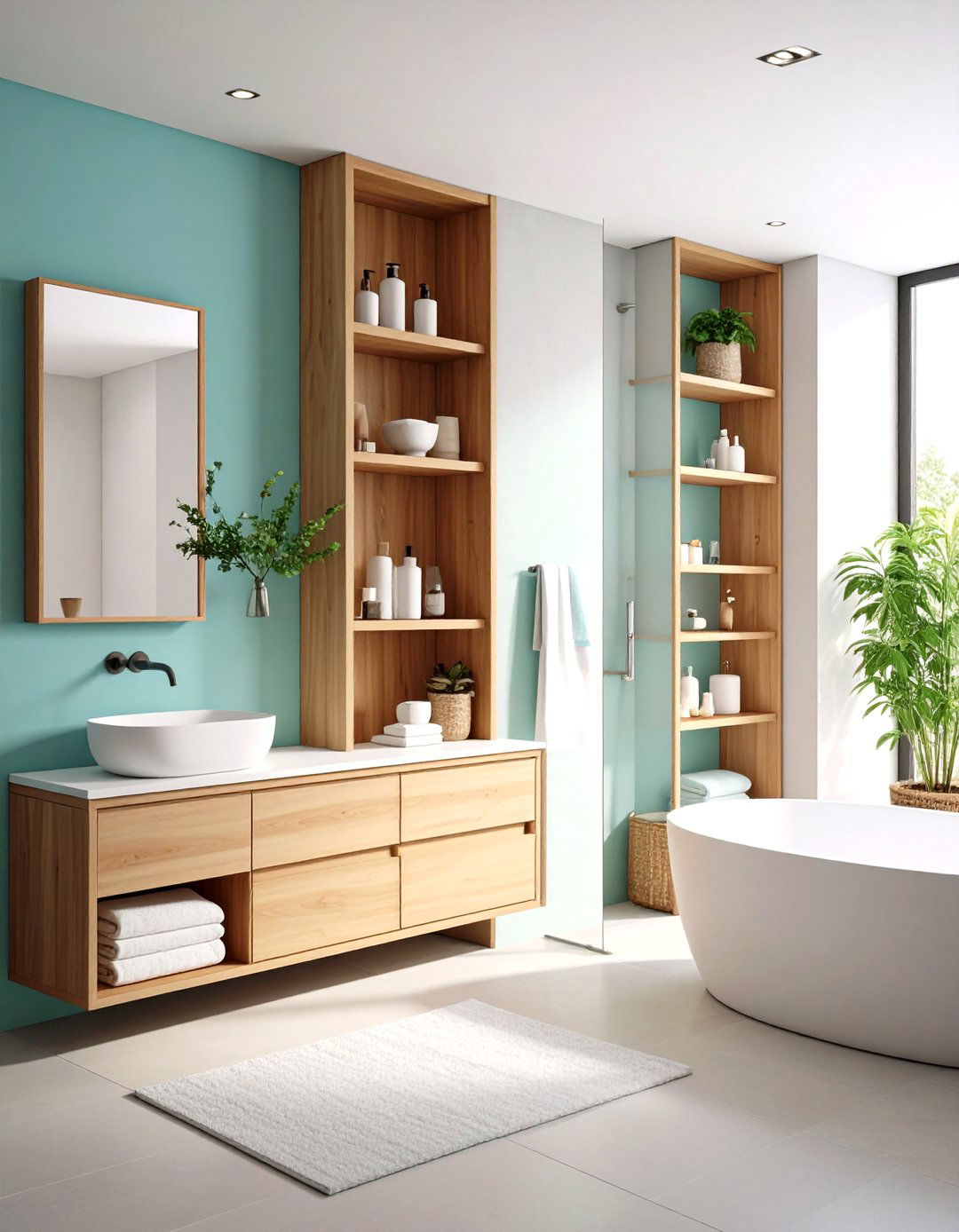
Built-in wall niches provide seamless storage solutions in Japandi bathroom design, maintaining clean lines while offering practical space for toiletries and decorative elements. These architectural features eliminate the need for bulky storage furniture that can disrupt the minimalist aesthetic central to the style. Design niches with natural materials like stone or wood that complement surrounding surfaces while creating subtle visual interest through texture and depth. Consider multiple smaller niches arranged in geometric patterns, or single larger recesses that can accommodate plants, candles, or small decorative objects. The recessed design keeps storage invisible when not in use while ensuring essential items remain easily accessible. This approach demonstrates the Scandinavian emphasis on functional design that serves daily needs without compromising aesthetic goals. Proper lighting within niches can highlight displayed objects while contributing to the overall ambient atmosphere essential to creating peaceful bathroom environments.
15. Japandi Bathroom Wabi-Sabi Imperfection Elements

Embracing wabi-sabi principles adds authentic Japanese character to Japandi bathroom design by celebrating imperfection, impermanence, and natural aging processes. Choose materials and fixtures that showcase natural variations, weathered textures, or handcrafted irregularities rather than machine-perfect uniformity. Consider stone tiles with natural fissures, wooden elements with visible grain patterns, or ceramics with subtle asymmetries that reflect human craftsmanship. These imperfections create visual interest while supporting the philosophical foundation that finds beauty in authenticity rather than artificial perfection. Allow materials to age gracefully, developing patina and character over time rather than fighting natural weathering processes. This approach creates bathrooms that feel lived-in and genuine rather than sterile showrooms. The wabi-sabi aesthetic encourages mindful acceptance of life's transient nature while finding peace in present moments, making bathrooms sanctuaries for contemplation and personal renewal.
16. Japandi Bathroom Floating Shelf Minimalism
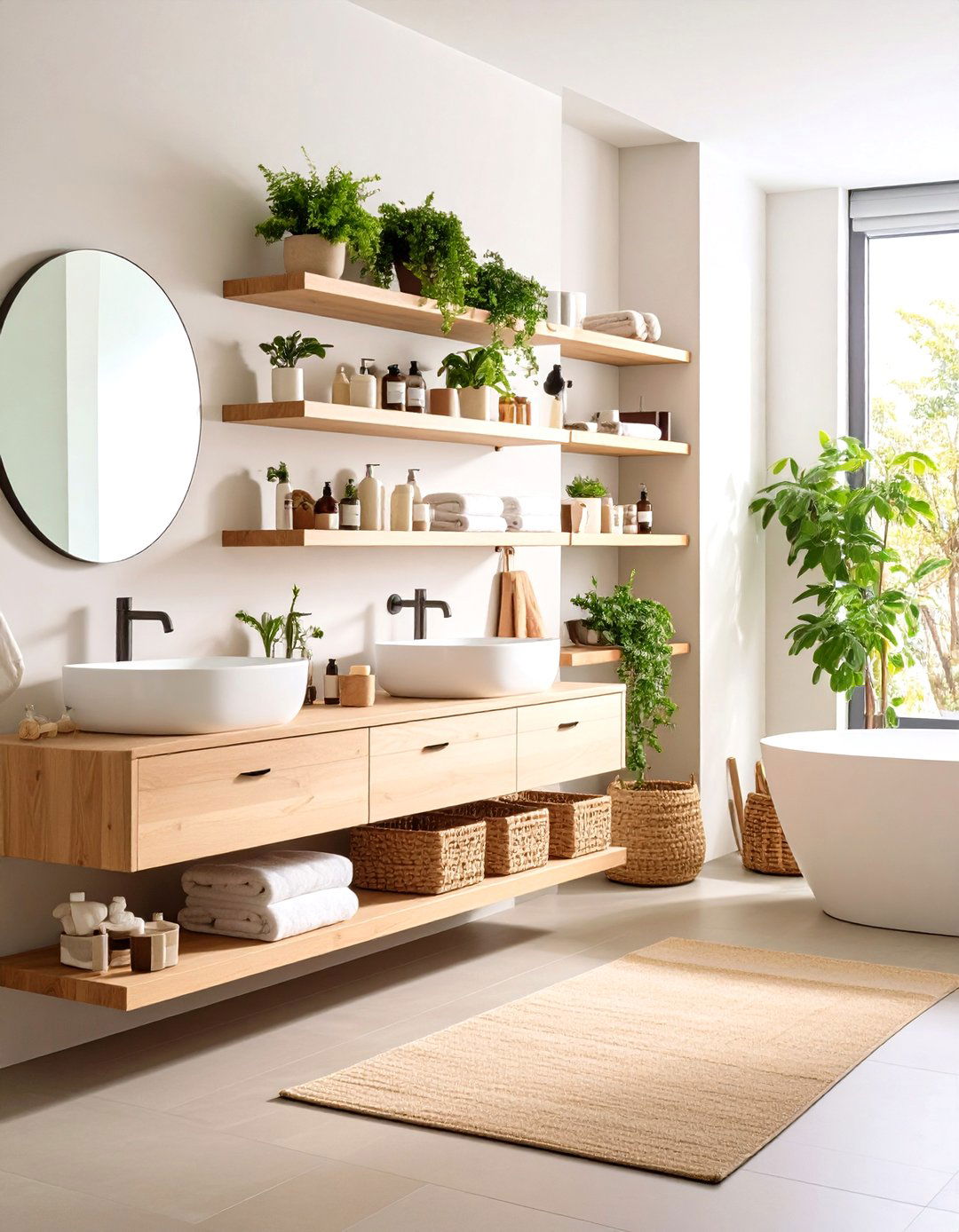
Floating shelves embody the Japandi bathroom aesthetic by providing essential storage while maintaining visual lightness and spatial flow. Choose shelves in natural wood that complement vanity materials while appearing to effortlessly suspend from walls without visible support hardware. These streamlined storage solutions keep floors clear and walls uncluttered while offering display space for carefully curated items like plants, candles, or minimal toiletries. The clean horizontal lines create visual balance against vertical elements while supporting the minimalist goal of reducing unnecessary visual complexity. Consider varying shelf lengths and heights to create interesting compositions without overwhelming the peaceful atmosphere. Quality craftsmanship ensures floating shelves support functional needs while appearing elegant and understated. This design approach demonstrates how thoughtful storage solutions can enhance rather than compromise the serene environment essential to successful Japandi bathroom design, proving that functionality and beauty work together harmoniously.
17. Japandi Bathroom Rain Shower Head Experience
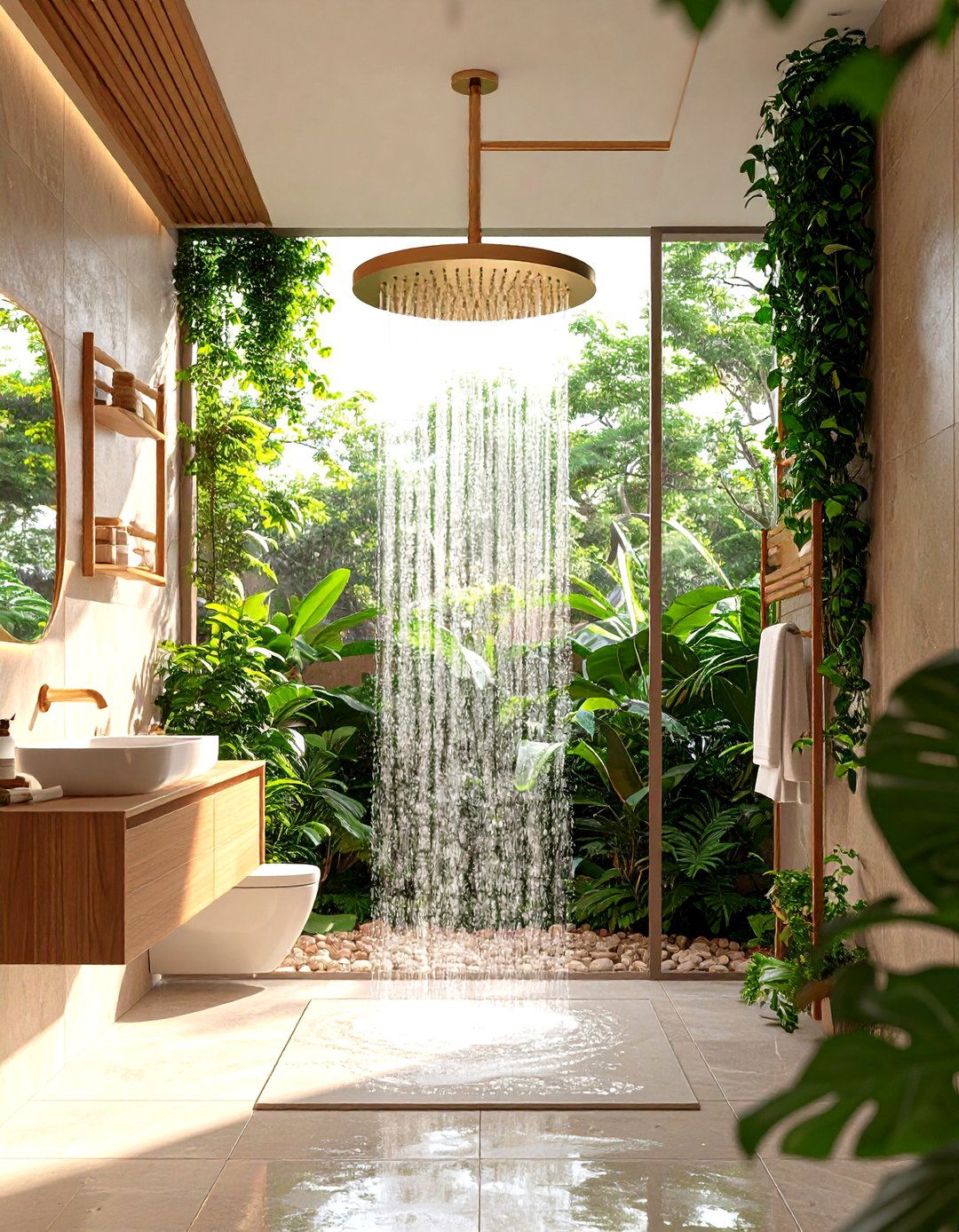
Rain shower heads transform daily cleansing routines into spa-like experiences that align perfectly with Japandi bathroom philosophy emphasizing mindfulness and self-care. Choose large, circular designs with clean geometric forms that provide gentle, even water distribution reminiscent of natural rainfall. The immersive experience encourages slowing down and being present in the moment rather than rushing through daily routines. Position shower heads strategically to maximize the calming effect while ensuring practical functionality for hair washing and body cleansing. Consider ceiling-mounted installations that create dramatic visual impact while maintaining clean wall lines essential to minimalist design. Matte black or brushed finishes complement the neutral palette while providing subtle contrast against light backgrounds. The gentle water pressure promotes relaxation while reducing water consumption compared to high-pressure alternatives, supporting the environmental consciousness central to Japandi design principles.
18. Japandi Bathroom Natural Fiber Bath Mat Comfort

Natural fiber bath mats bring essential comfort to Japandi bathroom design while supporting the environmental consciousness and material authenticity central to this aesthetic. Choose mats made from bamboo, cotton, jute, or linen that provide softness underfoot while complementing the neutral color palette and natural material emphasis. These organic materials absorb moisture effectively while resisting mold and mildew in humid bathroom environments. Consider woven textures that add subtle visual interest without overwhelming the minimalist design goals. The natural fibers age gracefully, developing character over time that aligns with wabi-sabi principles celebrating impermanence and authenticity. Position mats strategically near bathtubs, showers, and vanity areas to provide comfort during daily routines while maintaining the clean, uncluttered appearance essential to successful Japandi design. Quality natural fiber mats combine functionality with beauty, demonstrating how practical elements can enhance rather than compromise the peaceful atmosphere.
19. Japandi Bathroom Zen Garden Corner Creation

Creating a dedicated zen garden corner transforms Japandi bathrooms into meditation spaces that support mental wellness alongside physical cleansing. Design a small area featuring elements like carefully arranged stones, sand patterns, miniature plants, or simple water features that encourage mindful contemplation. Choose a shallow wooden or stone tray that can accommodate changing seasonal displays or personal meaningful objects that inspire reflection. This dedicated space serves as a visual reminder to pause and breathe during busy days while honoring Japanese garden traditions that find profound beauty in simple natural arrangements. The corner should feel integrated into the overall design rather than added as an afterthought, supporting the bathroom's role as a personal sanctuary. Consider how natural light interacts with the zen garden throughout the day, creating shadows and highlights that change the display's character. This thoughtful addition demonstrates how Japandi design can nurture both body and spirit.
20. Japandi Bathroom Warm LED Lighting Fixtures

Thoughtfully designed LED lighting fixtures complete the Japandi bathroom atmosphere by providing energy-efficient illumination that supports both environmental goals and aesthetic vision. Choose fixtures with natural materials like wood, bamboo, or paper that diffuse light gently while creating visual interest through texture and form. Warm color temperatures between 2000-2700 Kelvin create golden glows that feel natural and inviting rather than harsh or clinical. Consider pendant lights with organic shapes that complement other curved elements while providing task lighting over vanity areas. Layer multiple light sources to create flexibility for different activities and moods throughout the day. Dimmable options allow for customization based on whether the space is being used for energizing morning routines or relaxing evening wind-down rituals. These carefully selected fixtures demonstrate how modern technology can support traditional design principles while creating spaces that feel both contemporary and timeless.
Conclusion:
Japandi bathroom design offers a timeless approach to creating peaceful, functional spaces that nurture both body and spirit. By thoughtfully combining Japanese minimalism with Scandinavian warmth, these 20 ideas demonstrate how natural materials, neutral colors, and mindful design choices can transform ordinary bathrooms into extraordinary sanctuaries. The key lies in embracing simplicity without sacrificing comfort, celebrating imperfection while maintaining functionality, and creating spaces that encourage mindful living. Whether implementing subtle changes or complete renovations, these Japandi principles will help you design a bathroom that serves as a daily retreat from modern life's complexities.


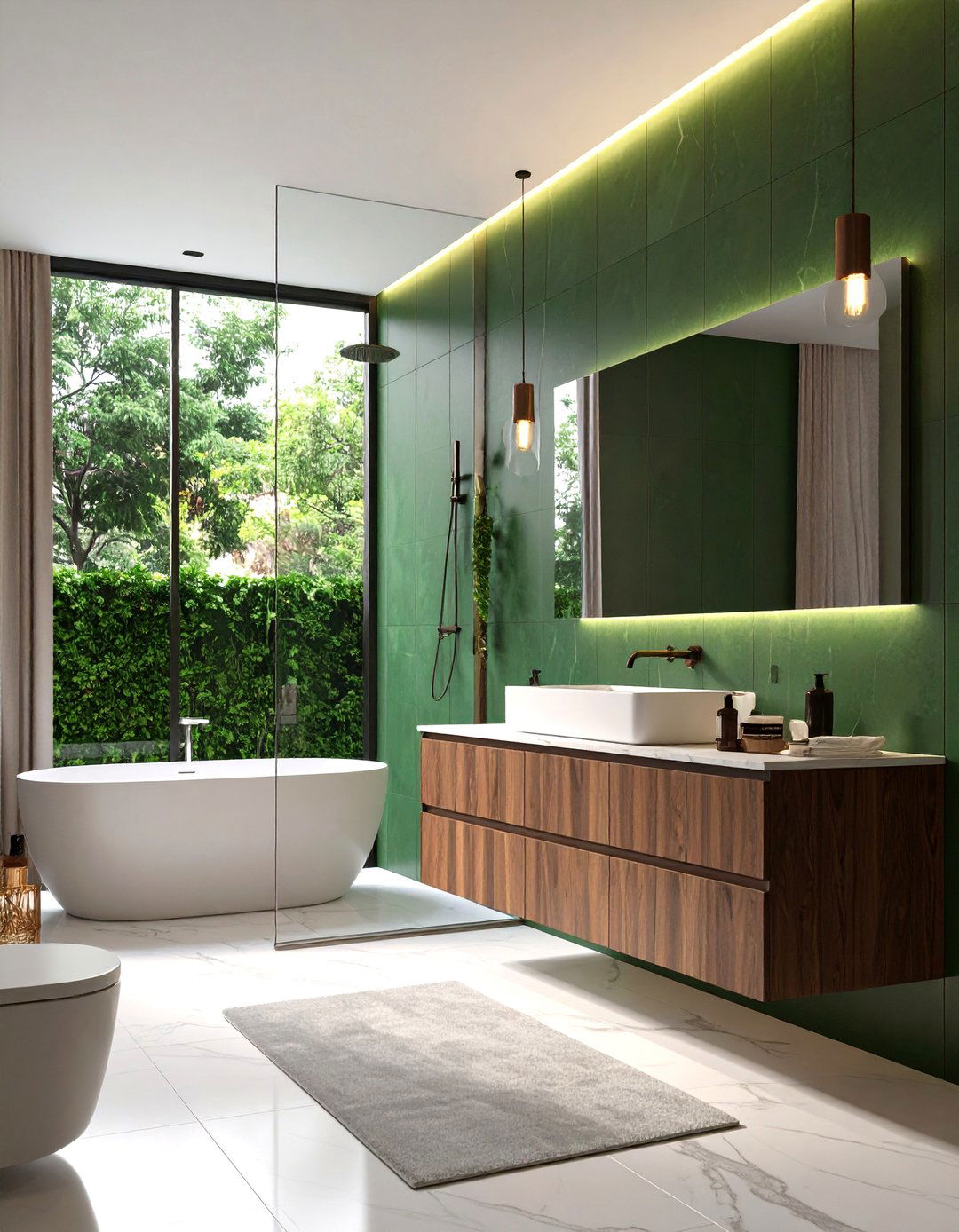

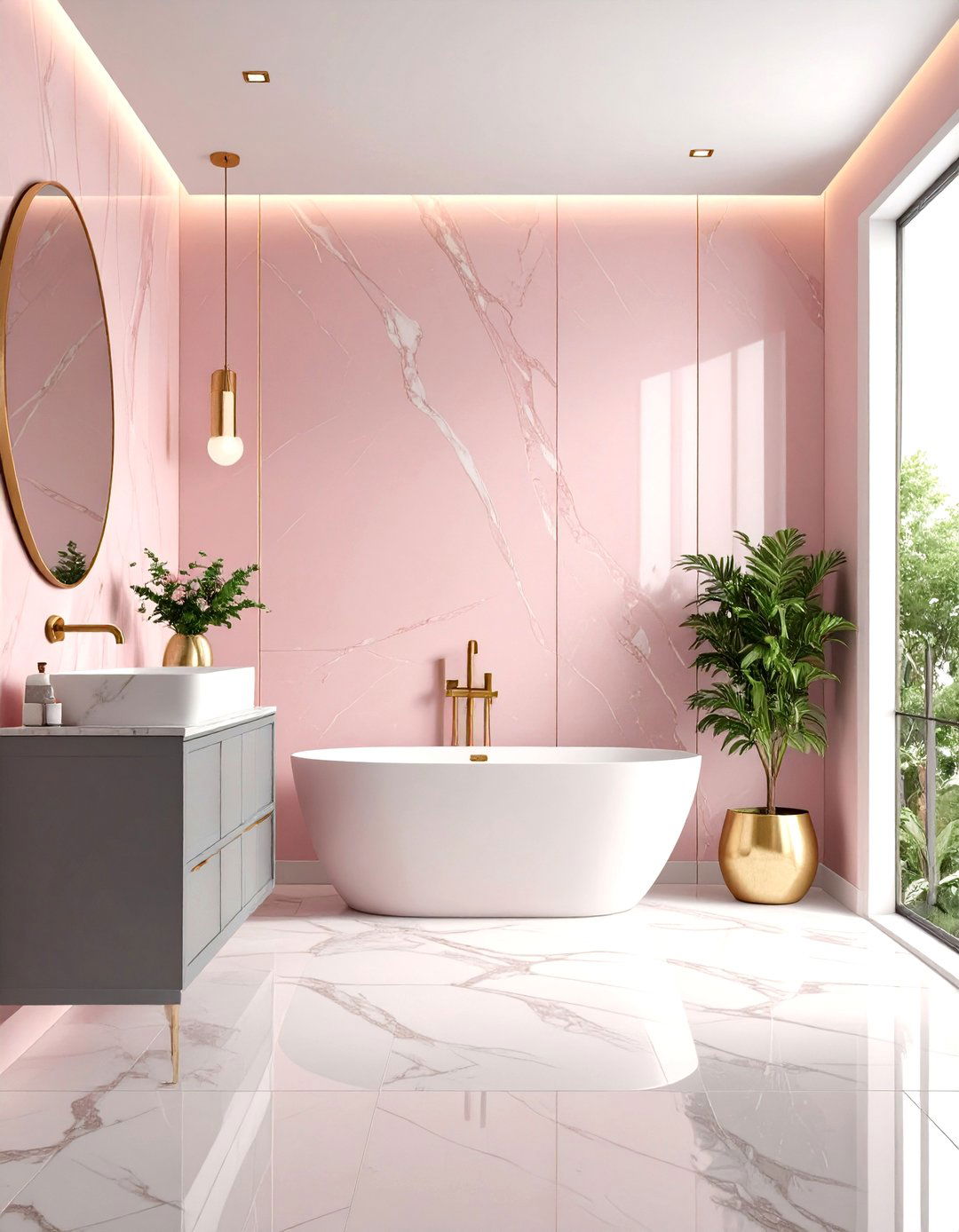
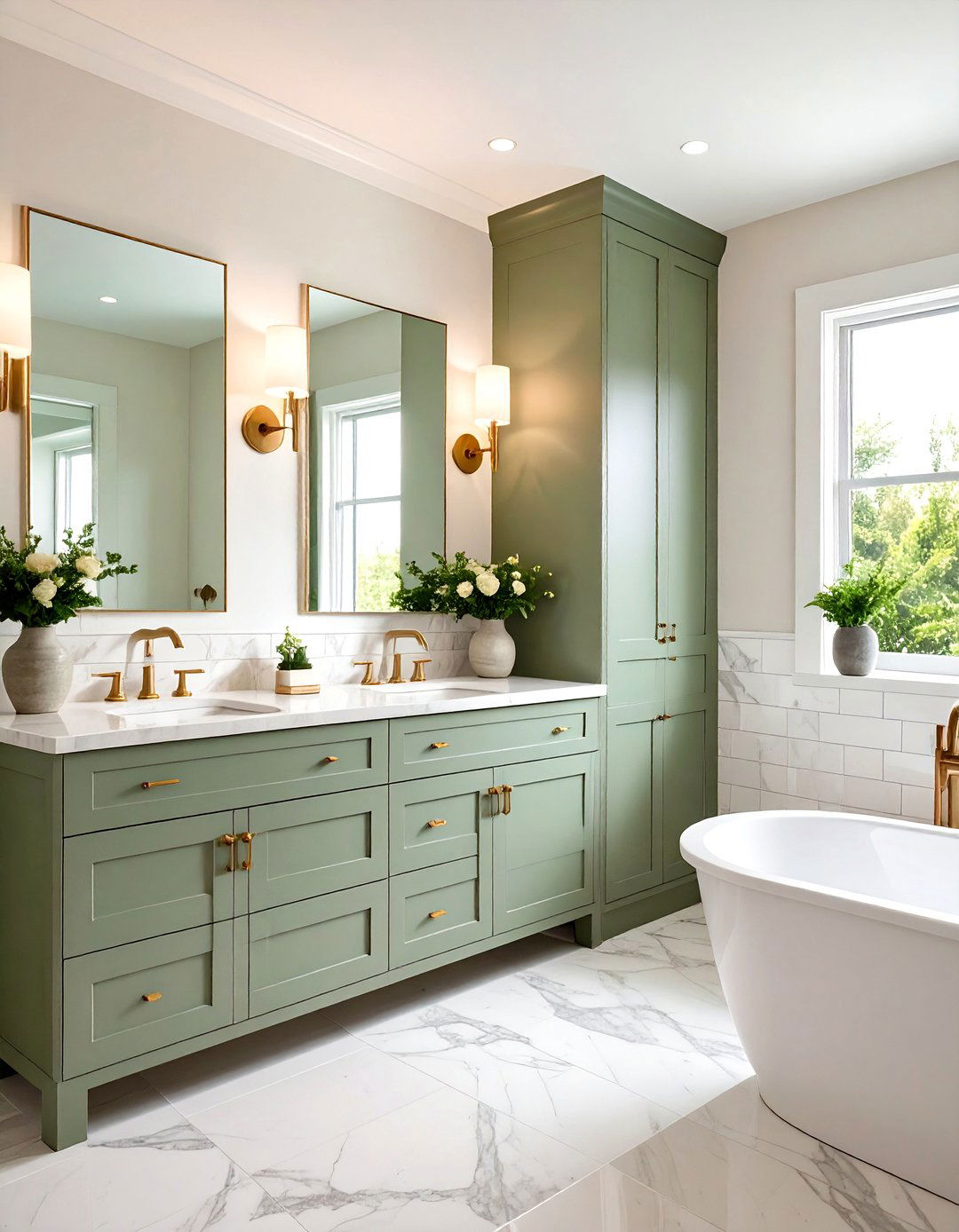
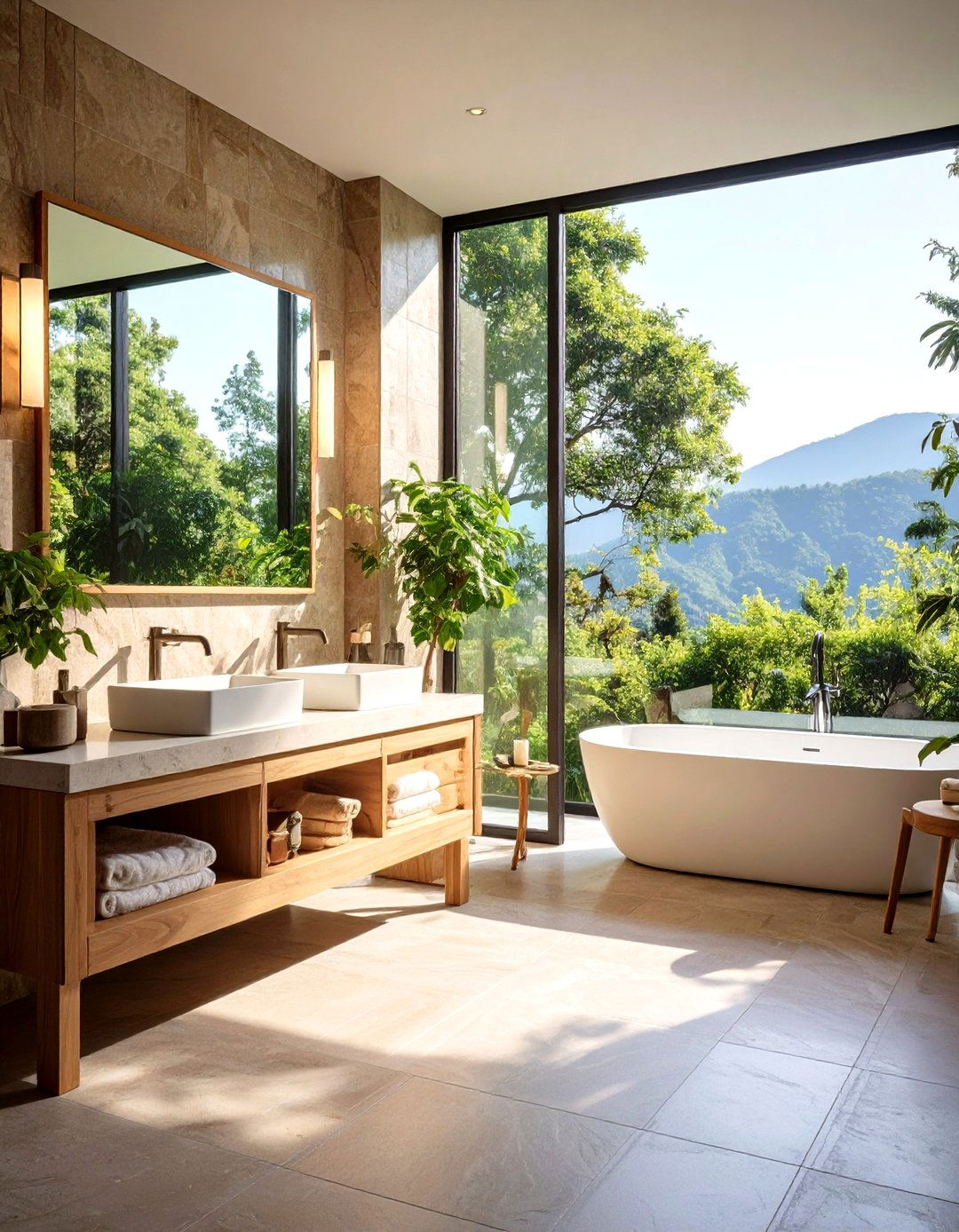

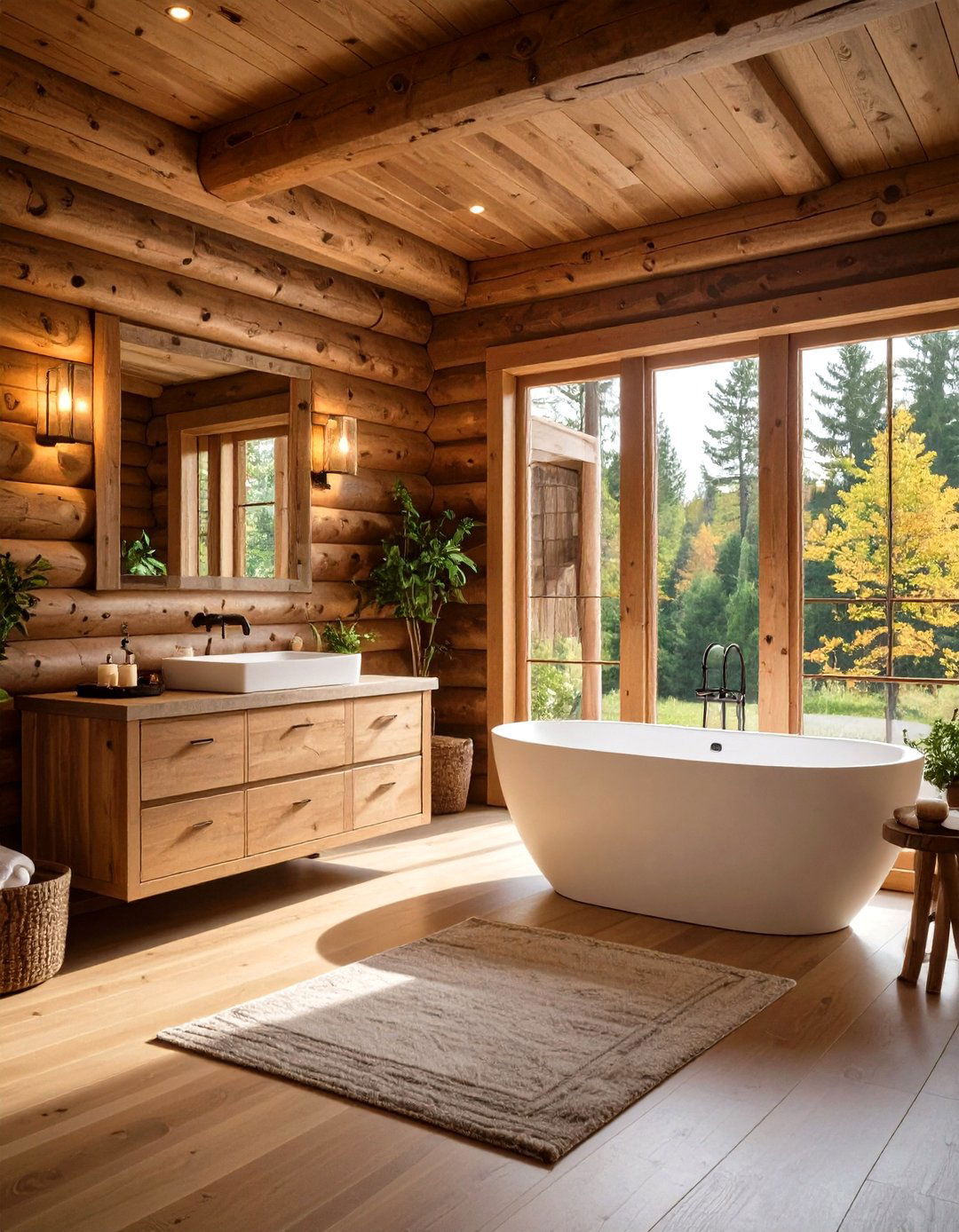
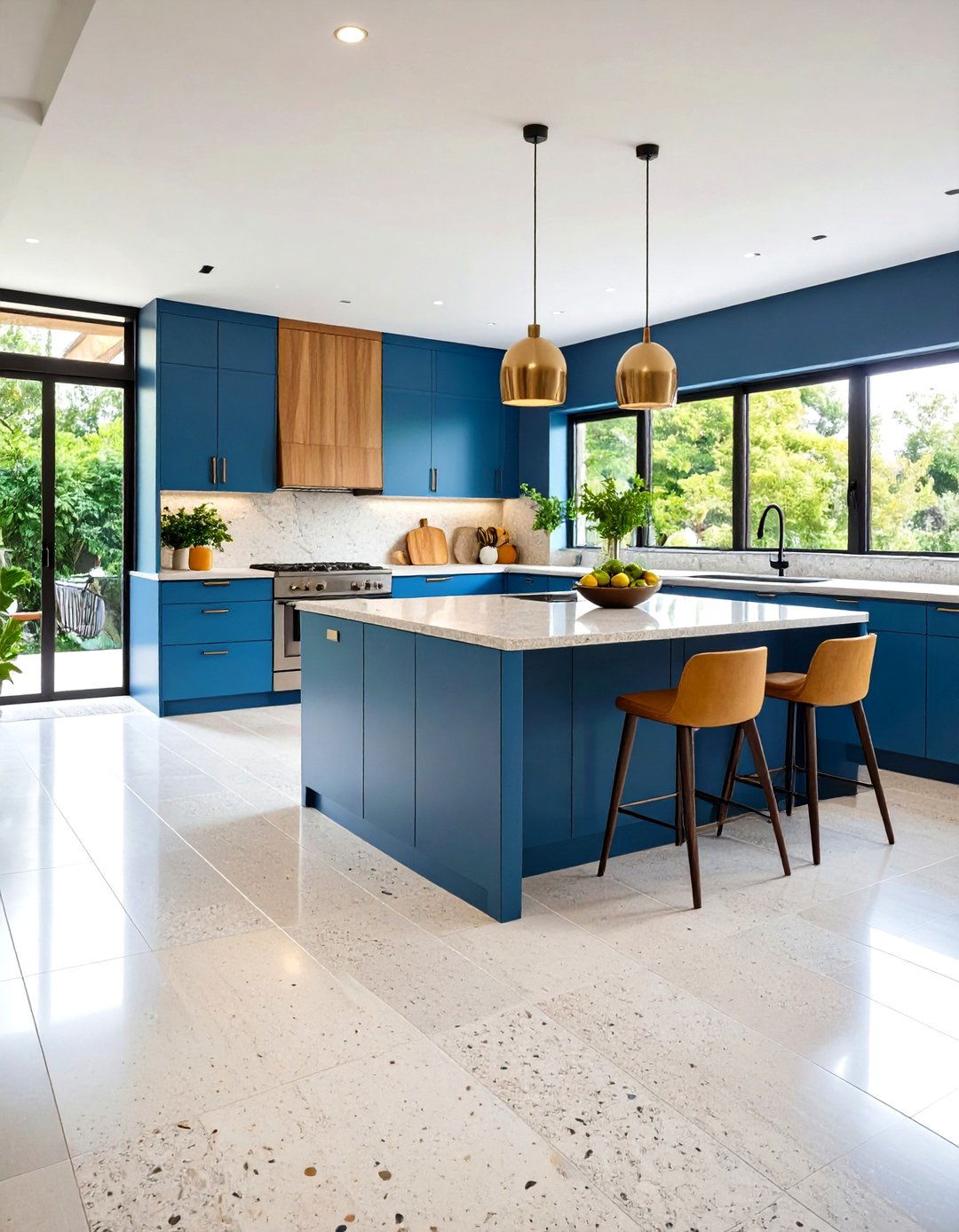
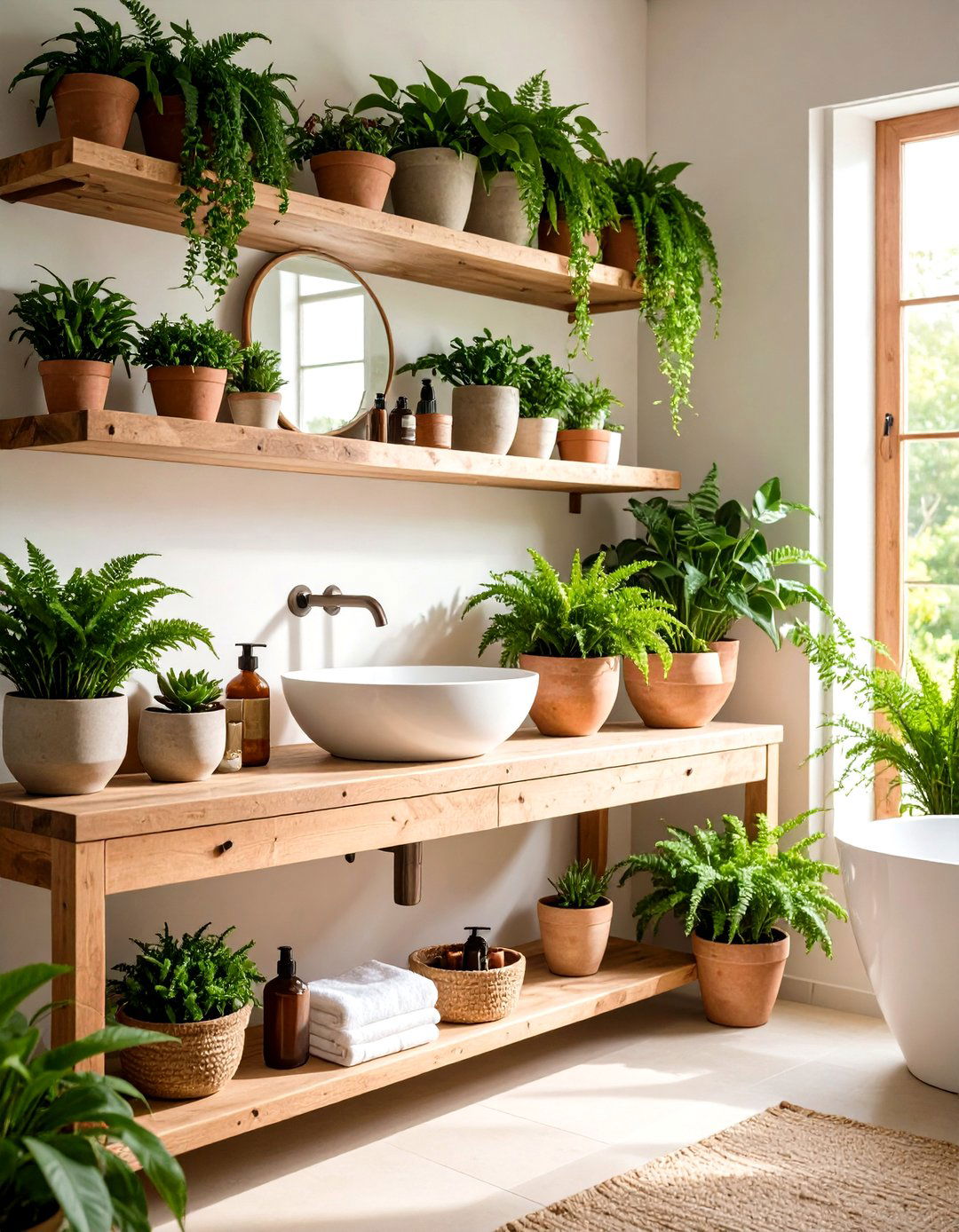

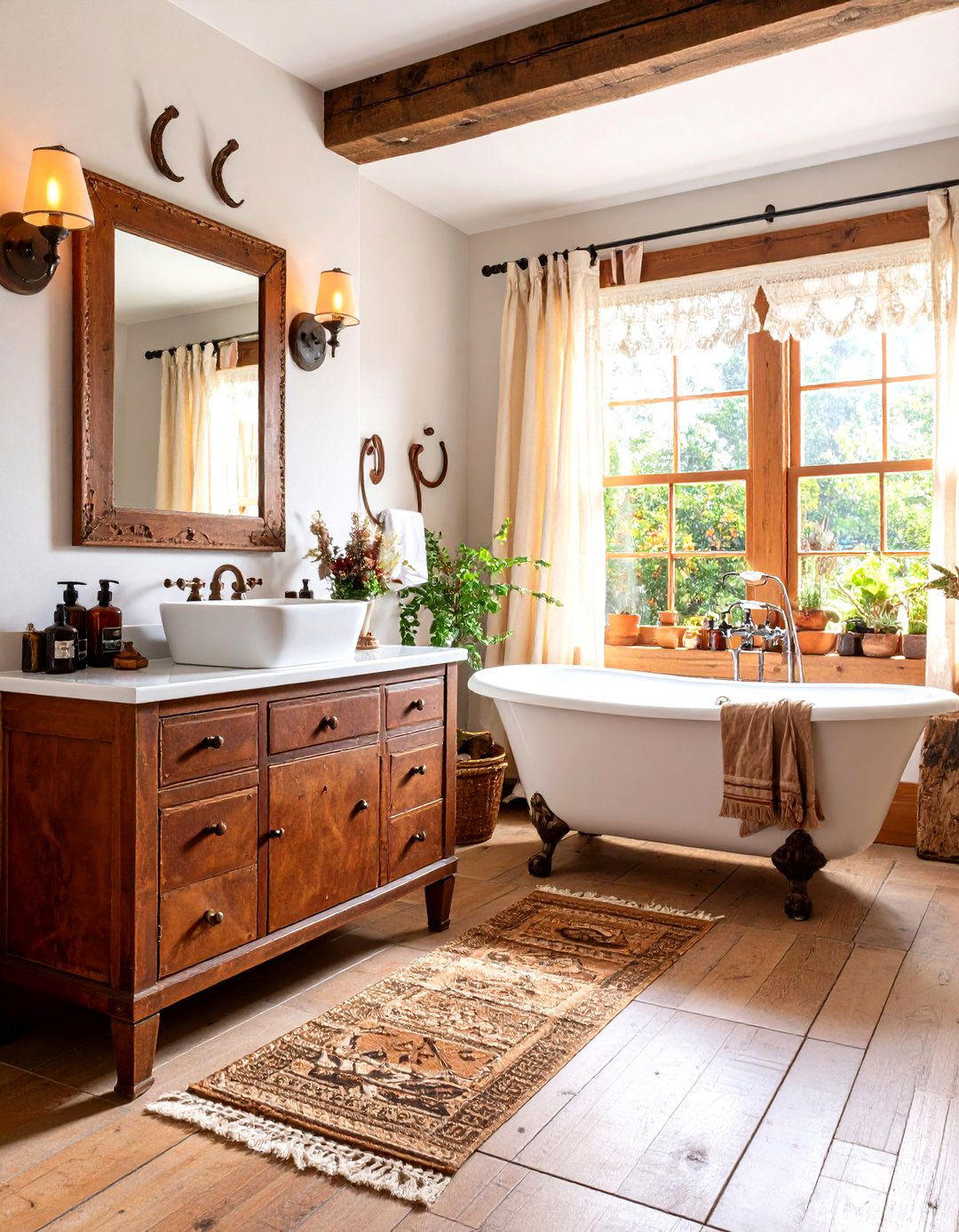
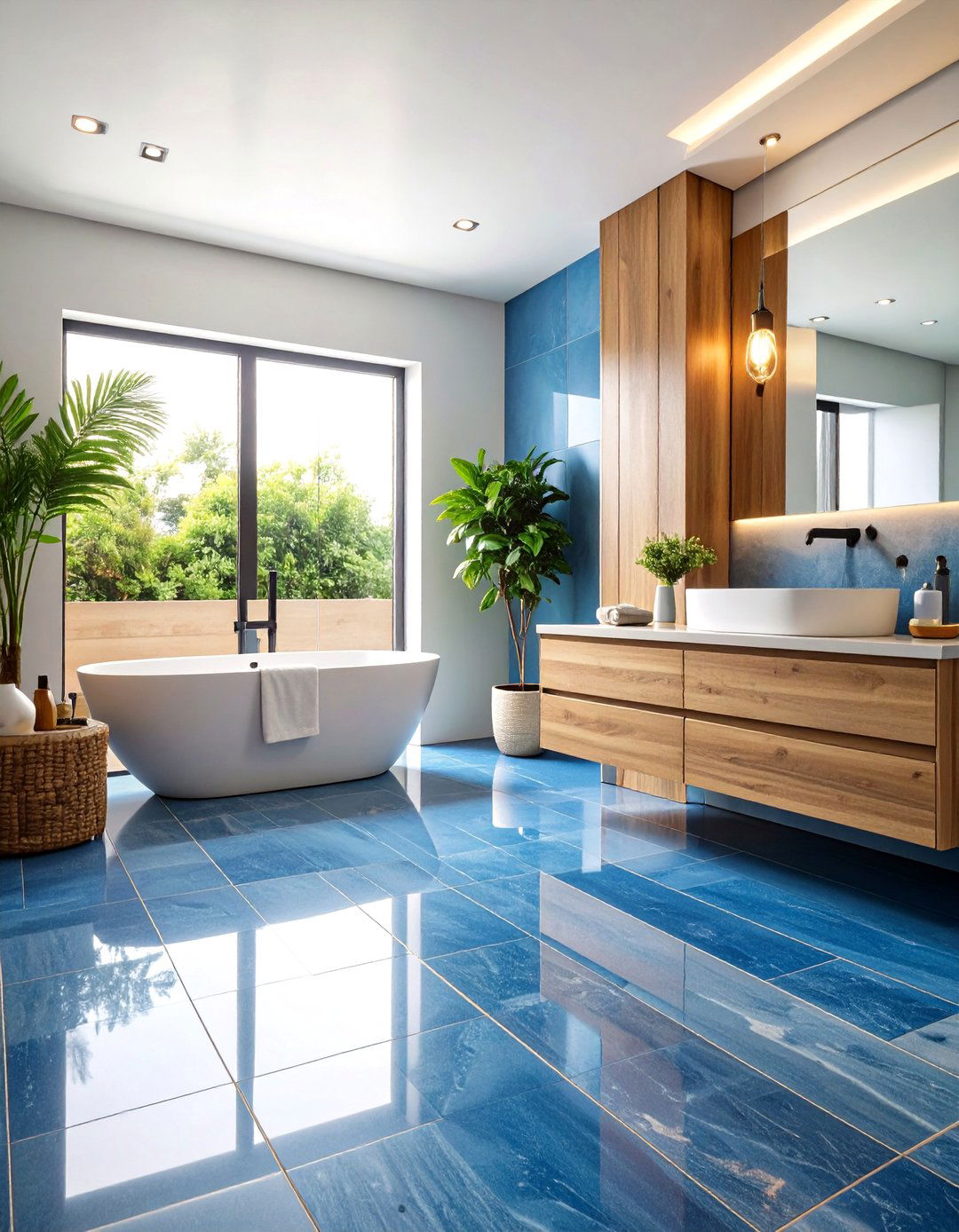

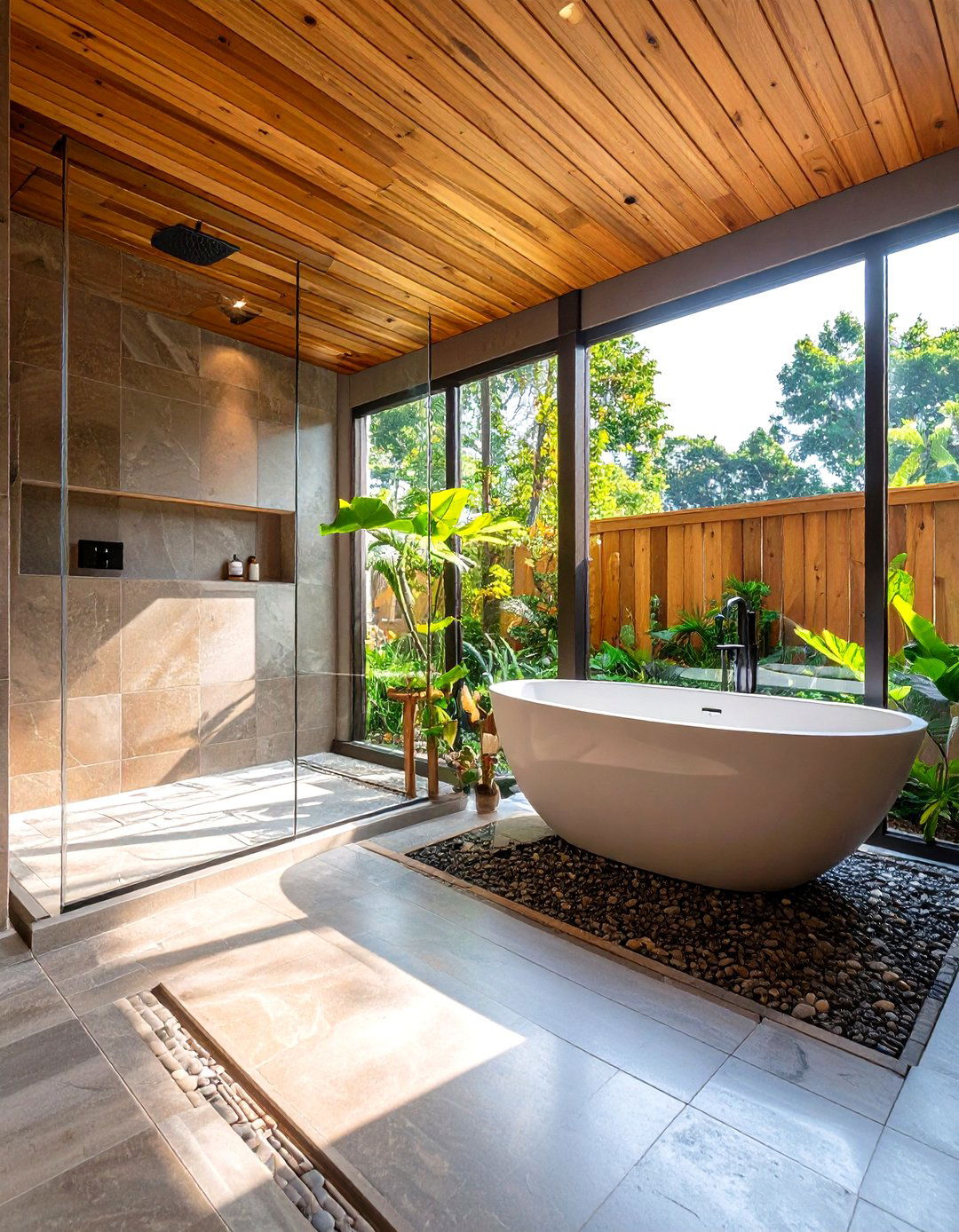
Leave a Reply